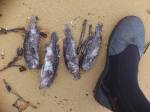1. Mr Ong Kim Pit’s fish farm in Lim Chu Kang was hit on Friday by mass fish deaths, which had first affected farms in the east of the island. He has lost more than 60,000 baby and adult Mullet fish, with losses estimated at $10,000. Photo by Lau Fook Kong
2. Friends Wong Jing Kai (left) and Bryan Ang, who went into partnership with Mr Teh Aik Hua, 60, who owns Ah Hua Kelong, lost 80 per cent of their fish in the recent mass fish deaths at their farm near Pasir Ris. Photo by Seah Kwang Peng
Fish deaths: Fish farmers mentally prepared for more losses, and resigned to fate
The plankton bloom that hit fish farms along the Johor Strait has caused millions of dollars in losses, and plenty of heartache. But while some farmers have decided to simply take it on the chin, others are fighting back. The Straits Times speaks to five farms.
By Carolyn Khew, 9th March 2015;
It has been a tough weekend for 65-year-old fish farmer Ong Kim Pit.
On Friday, his Lim Chu Kang fish farm was hit by mass fish deaths, which had first affected farms in the east of the island.
He lost more than 60,000 baby and adult Mullet fish (Flathead Grey Mullet) (Mugil cephalus), with losses estimated at $10,000.
But he appears to be resigned to his fate.
He said he is aware there are closed rearing systems that can help to isolate fish from the harmful effects of plankton blooms.
But the farmer, who has been in the business for about 20 years, said he is not going to stop using net cages, in which fish are reared in the sea.
When asked why, he said rearing fish in containers is “not so simple” because of the heavy costs involved.
There are also limits on how much fish one can raise in a container, he added.
Besides, the father of three sons, aged 27 to 34, plans to retire in a few years’ time. And he does not want his kids to take over his business as it is a hard life.
“You have to be in the sun and rain a lot and, frankly, I think young people are scared of that,” said Mr Ong.
He said he buys his Mullet and Milkfish (Chanos chanos) fingerlings from Indonesia and feeds them bread and instant noodles for about 11/2 years before he sells them.
He said a similar plankton bloom could see him suffer more loses.
“If I can clear my stock quickly, I’ll do it,” he added.
“The only other thing I can do is to prepare myself mentally. Once the bloom comes, the fish will be gone.”
Source: The Straits Times
Fish deaths: Duo turn to online crowdsourcing for help
By Isaac Neo, 9th March 2015;
Fish farming might seem unattractive to most young people, but in the case of 26-year-olds Wong Jing Kai and Bryan Ang, their youth has been a plus.
Last April, the two friends from national service went into partnership with Mr Teh Aik Hua, 60, who owns Ah Hua Kelong.
The farm rears Golden Pomfret (Snubnose Pompano) (Trachinotus blochii), Sea Bass (Barramundi) (Lates calcarifer) and Pearl Groupers (Brown-marbled or Tiger Grouper X Giant Grouper) (Epinephelus fuscoguttatus X lanceolatus), along with mussels and crabs.
The recent plankton bloom wiped out 80 per cent of their entire stock at their farm just five minutes away from Lorong Halus on the north-east coast near Pasir Ris.
The remaining 20 per cent was saved after being moved to their farm in Sembawang.
But they still needed help.
So, the Internet-savvy new partners turned to online crowdsourcing and raised over US$12,000 (S$16,500) through the Indiegogo website.
The money, they said, was needed to help them cover their operating costs. “We are thankful to those who have supported us, it would have been much tougher without them,” said Mr Wong.
They also plan to downsize the Pasir Ris farm and expand their Sembawang farm, which was unaffected by the bloom.
They estimate it will take them at least nine months to get their business back on track and, even then, they may never be able to recover everything. However, they remain optimistic.
They believe their business model which includes delivering the produce straight to households – a plan which the two new partners came up with – is one that will work. Said Mr Ang: “Seafood is something that most Singaporeans really like.”
Source: The Straits Times
![28763236_392418971236941_5594753751299653632_n[1]](https://mondaymorgue.wordpress.com/wp-content/uploads/2018/03/28763236_392418971236941_5594753751299653632_n1.jpg?w=730)
![29093124_368704833613036_3875292452231315456_n[1]](https://mondaymorgue.wordpress.com/wp-content/uploads/2018/03/29093124_368704833613036_3875292452231315456_n1.jpg?w=730)
![27581585_1465348193594383_4165942213525635072_n[1]](https://mondaymorgue.wordpress.com/wp-content/uploads/2018/02/27581585_1465348193594383_4165942213525635072_n1.jpg?w=730)




























